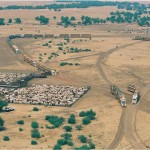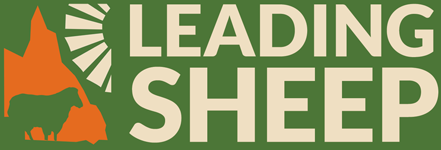Welcome to the April edition of ‘Around the Camp’. There are a variety of articles for you this month and a whole heap of events – hopefully you will find one that interests you. Here’s hoping for some more rain and a happy Easter to all.
- Wild dog funding still available
- Changes to livestock transportation code
- Are you the next Nuffield Scholar?
- ParaBoss
- Upcoming events
- eBulletins
1. Wild dog funding still available
37 groups have now been funded under the Australian Wool Innovation “Community Wild Dog Control Initiative”. A recent survey of the recipients of this funding (1227 participants) revealed 31% intend to reintroduce sheep, 37% intend to increase their wool production and 54% noticed an increase in native animals. This funding is for on ground activities to kill wild dogs.
Funding is still available and if you would like to apply, please complete the Wild Dog Control application form and submit it along with a map and project budget to wilddogs@wool.com. If you need clarification or assistance please contact Taran Blyth at AWI on (02) 8295 3164.
2. Changes to livestock transportation code
How long can a pregnant sheep be transported without water? Not sure? Find out in the code of practice for transport of livestock
The code of practice for transport of livestock (the Code) is the result of discussions nationally between the livestock industries, scientists, welfare agencies and government. It aims to safeguard the welfare of livestock being transported. The Code covers the transport of both commercial and non-commercial livestock and applies once livestock are assembled prior to loading and continues until the livestock are unloaded at the final destination. The Code aligns Queensland with other states and territories to achieve a nationally consistent approach to livestock transport.
Compliance with the Code became compulsory under the Animal Care and Protection Act 2001 on 31 January 2014; however there is a qualified six month grace period for enforcement ending 1 August 2014. It is recommended that producers, drivers and receivers of livestock familiarise themselves with the laws and ensure they are compliant. The Code includes the responsibilities of those involved in the transport, maximum times off water, ensuring that livestock are fit for the intended journey, handling rules and special considerations.
Under the Code, animals that are not fit for the intended journey must not be transported. It is the responsibility of the consignor and the transporter to ensure the animals are fit for the intended journey. The Code applies to the following animals being transported by road, rail or by container or vehicle aboard a ship: Alpaca, Buffalo, Camel, Cattle, Sheep, Goats, Horses, Pigs, Poultry, Ostriches, Emus and Deer.
Biosecurity Queensland has held the first in a series of webinars to help answer any questions around the changes to the compulsory requirements for transporting livestock. For further information and details of future webinars, producers can contact Biosecurity Queensland on 13 25 23 or visit www.business.qld.gov.au
For information on the national animal transportation standards, visit www.australiananimalwelfare.com.au
3. Are you the next Nuffield Scholar?
Growing the world’s best: Nuffield Australia is offering 26 scholarships to primary producers across the country. Worth $30,000 each, the scholarships enable successful applicants to travel the world researching a topic of importance to them personally and their broader industry. Applications open close 30 June. Click here to view the 2015 brochure.
Application forms can be downloaded from www.nuffield.com.au
Australian Wool Innovation supports the 2015 Nuffield Farming Scholarships. Details of past AWI Nuffield Scholars can be found by clicking here.
4. ParaBoss
ParaBoss is a suite of three products developed for the management of blowflies, worms and lice. The WormBoss, FlyBoss and LiceBoss websites are sources of detailed management information and regional programs that will assist in managing the major parasite risks for sheep. They have been developed by expert panels of parasitologists and veterinarians from across Australia.
To check out these websites click here.
5. Upcoming events
- 23 April 9.30 am – 1 pm Drought Assistance Information Session in Toowoomba, click here to view flyer.
- 28 – 30 April from 5.30pm for a free BBQ and forum starts at 7pm “The Road to Resilience” in Charleville, Quilpie and Cunnamulla, click here to view flyer.
- 28 April – 2 May Australian Government Mobile Service Centres in town to provide support to drought-affected communities in Cunnamulla, Eulo, Thargomindah, Wyandra and Quilpie, click here to view the full schedule of times and locations.
- 2 May 2pm Beyond Reasonable Drought in Charleville, click here to view flyer.
- 5 May half day Business EDGE follow up at Charleville, click here to view the flyer and registration form.
- 5 – 6 May from 5.30pm for a free BBQ and forum 7pm Tie Up the Black Dog Committee presents an evening with Craig Hamilton in Injune and Wallumbilla, click here to view flyer.
- 7 May from 5.30pm for a free BBQ and forum 7pm Tie Up the Black Dog Committee presents an evening with Craig Hamilton in Thallon, click here to view flyer.
- 6-8 May Nutrition EDGE workshop in Longreach, click here to view the flyer and registration form.
- 9-10 May Qld State Sheep Show in Barcaldine
- 9 May 3pm Selecting the all purpose Merino workshop for 18-35 year olds in conjunction with the Qld State Sheep Show in Barcaldine.
-
9 May 6.45pm Qld Merino Stud Sheepbreeders Association dinner in conjunction with the Qld State Sheep Sheep in Barcaldine, click here to view the invite.
- 10 May 7am breakfast and forum 8am-10.45am Qld Sheepmeat producer breakfast forum in conjunction with the Qld State Sheep Show in Barcaldine, click here to view flyer.
-
10 May 1.30 pm Visual attributes of ram selection and correlation to ASBVs workshop for 18-35 year olds in conjunction with the Qld State Sheep Show in Barcaldine.
-
10 May (tbc) Understanding wool – clip preparation, buyer demands and outlook and understanding test results workshop for 18-35 year olds in conjunction with the Qld State Sheep Show in Barcaldine.
- 19-20 May 5.45pm for a free BBQ and forum to follow Tie Up the Black Dog Committee presents an evening with Wayne Wigham in Winton and Longreach, click here to view flyer.
- 20 June Predator control field day in Mitchell, click here to view details.
- 9 July Sheep CRC final conference Adelaide, click here to view details.
- 9-11 July LambEx in Adelaide, click here to view details.
6.eBulletins
The Feral Flyer, Invasive Animals CRC e-newsletter, Issue 245 – 25 March 2014
AWI Woolgrowers’ eNewsletter, March 2014
South West NRM, Three Rivers Three Creeks e-newsletter, March 2014
